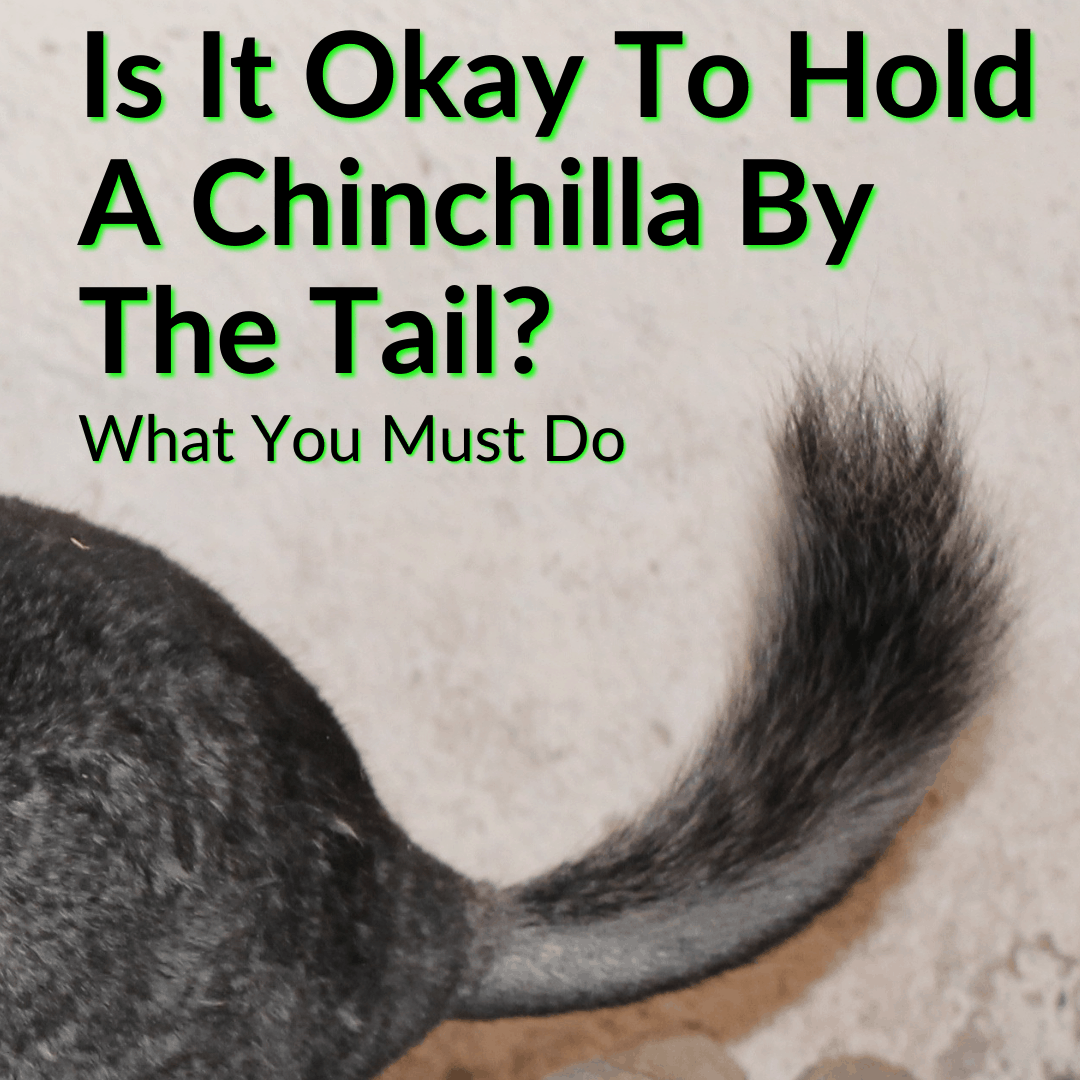
Or it simply feels like grabbing a chinchilla by the tail would hurt.
That’s a perfectly natural feeling.
The thought of grabbing my pet by the tail freaked me out too at first!
But I made sure to ask the breeder where I bought my chin if it is ok to hold a chinchilla by the tail.
And he reassured me that it is. But only if you do it right.
Keep reading to learn everything you need to know about grabbing your chinchilla by the tail correctly, plus some alternatives if you don’t feel up to it yet.
Contents
- 1 Is It Okay To Hold A Chinchilla By The Tail?
- 2 Holding A Chinchilla By The Tail
- 3 How To Pick Up Your Chinchilla By The Tail
- 3.1 Use Your Dominant Hand To Grab The Base Of The Tail
- 3.2 Once You Are Supporting Its Weight, It Will Begin To Relax
- 3.3 Always Support Your Chinchilla From Below For Safety And Comfort
- 3.4 Use A Chinchilla Playpen To Practice The Base Of The Tail Technique
- 3.5 What If You Can’t Pick Your Chinchilla Up By The Tail?
- 4 Hold A Chinchilla By The Tail: Final Thoughts
Is It Okay To Hold A Chinchilla By The Tail?
Yes, it is okay to pick up a chinchilla by the base of the tail. Ensure that you are grab it at the base of the tail, near the butt of the chinchilla.
Picking your chinchilla up any further down the tail can cause the tail to break and your pet to be in pain. This is especially true if you are grabbing near the tip of the tail.
Do chinchillas’ tails fall off? No, they are not like lizards, so you don’t have to worry about that. But you can cause an injury by grabbing the wrong part of the tail. However, grabbing it near the base is perfectly fine. In fact, it is ideal.
I’m sure if you haven’t seen or heard this before, you may be a little confused and may even think I’m crazy.
But it’s actually the best way to pick up your chinchilla to maintain control and to avoid it potentially biting you. At least in the beginning, before it fully trusts you.
Don’t worry, chinchillas don’t typically bite. But it can happen when you first get yours and it is not yet used to you and to it’s environment.
In this post, I want to detail some best practices for handling your chinchilla and discuss this tail holding technique a little bit more in-depth.
Hopefully, by the end of this post, you feel more comfortable and understand that it’s 100% okay to hold a chinchilla by the tail if it is done correctly.
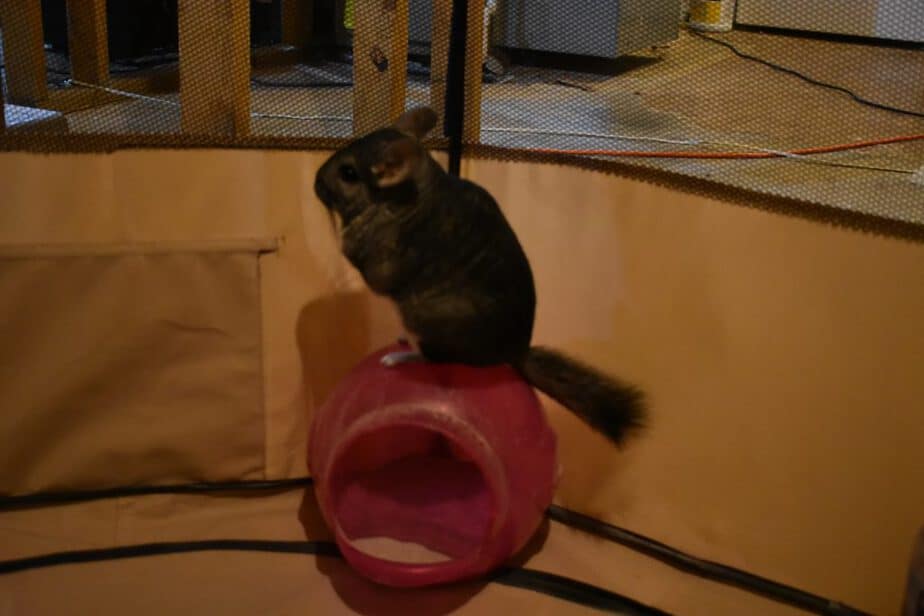
😕Adopting and caring for a new chinchilla can be intimidating and confusing. But it does not have to be.
Be sure to check out my full digital eBook “Avoiding Critical Mistakes: Ultimate Chinchilla Care eBook” for the best advice, tips, and tricks and supply recommendations to make adopting and caring for a chinchilla much more comfortable and easier to understand.
You can learn more about this eBook offer using the link directly below.
Learn more here:👉 Avoiding Critical Mistakes: Ultimate Chinchilla Care eBook Offer
Holding A Chinchilla By The Tail
It may feel weird to hold a chinchilla by the tail. It may even seem weird to be told that it is okay to pick a chinchilla up by the base of the tail.
I get it and it took me some time to adjust to this idea as well.
What I can tell you, however, is that it works. It’s actually the best practice, but only when you do it correctly. This means grabbing at the base of the tail only.
As I stated previously, grabbing your chinchilla by the tail is especially a good idea when you are first getting to know your chinchilla.
You see, chinchillas are friendly in most circumstances. However, many chinchillas don’t like to be held or picked up too often.
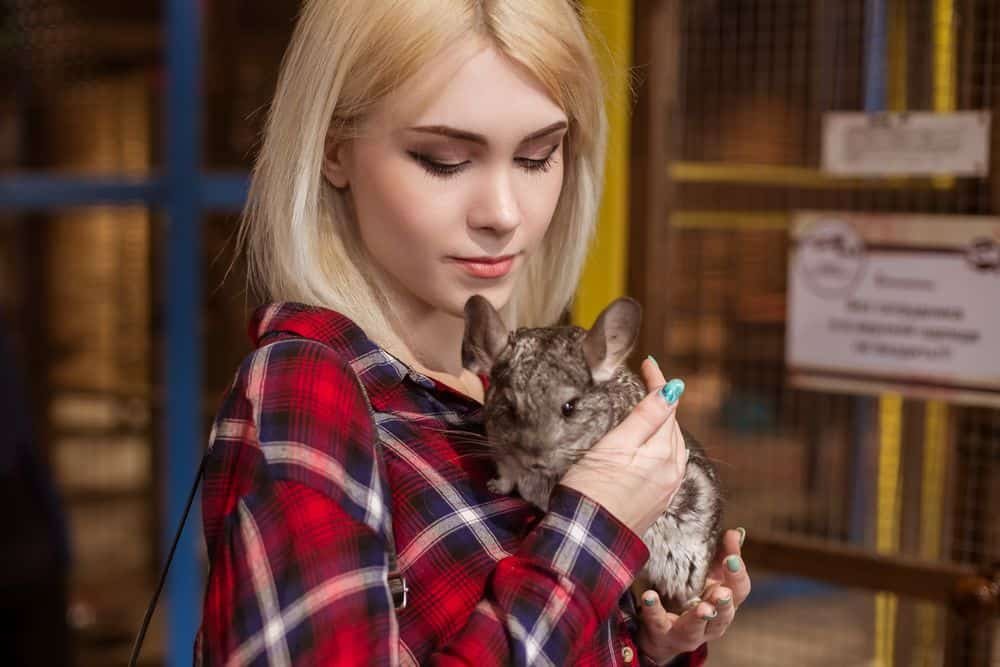
They may jump and climb all over you after some bonding time, but this doesn’t necessarily mean they love to cuddle up on the couch for an afternoon movie.
They don’t like to feel trapped, because they are preyed upon in their natural habitats.
Trying to get too touchy with them in the form of holding and grabbing, in the beginning, can result in a fur slip or even your chinchilla attempting to bite you (rare but possible).
On the flip side, some chinchillas are the complete opposite and you don’t have to use the tail technique to pick them up.
I’ve seen this in YouTube videos and my breeder also had some chinchillas that were so friendly or socialized that picking them up was a piece of cake.
If this is the situation you’re in, be thankful.
For me, I needed to use the base of the tail technique to grab my chinchilla for quite a while. Especially when I was trying to get my chinchilla in and out of the cage.
It’s not that she would ever bite me. She never has and never has even attempted to. She just gets squirrely and likes to jump when I need to hold her.
When I would attempt to pick her up in the beginning, she would run away and continue to do her thing.
Before diving into the specifics of how to pick your chinchilla up by the base of the tail, I first want to touch on some of the pros and cons of using the base of the tail technique.
Pros Of Holding A Chinchilla By The Base Of The Tail
👍Less chance of grabbing your chinchilla incorrectly and causing injury
👍Eliminates possibility of biting if performed correctly
👍Can be used as a technique to calm your pet
👍Easier to get your chinchilla in and out of the cage quickly
👍Recommended by many breeders (it is how I was taught to hold my chinchilla)
Cons Of Holding A Chinchilla By The Base Of The Tail
😔Extremely awkward feeling in the beginning
😔Potential to hurt your chinchilla’s tail if you grab too high up it
😔Chinchillas sometimes don’t like it
How To Pick Up Your Chinchilla By The Tail
So here is how you pick up your chinchilla correctly. Your pet is very fast (in case you didn’t know). In addition, cornering them never works. Nor should you ever corner a chinchilla if you want it to trust you in the future.
Remember, they are prey in the wild, not predators, so it’s normal for them to feel scared or run away from something as large as you.

Read that again if you need to.
A chinchilla will run away from you. This doesn’t mean it doesn’t love you or recognize you.
What I like to do is wait for my chinchilla to come to me. If you don’t force it, it doesn’t take long at all.
And I feel she respects me much more for not chasing her all over and trying to pin her in a corner.
After she sniffs and runs around, she will come to climb on my shoulders, head, and lay on my lap. When she does this, I don’t go crazy and immediately try and capture her or do anything too jumpy with her.
I simply wait till she’s hanging out near me and I can tell she’s okay with playtime coming to an end.
Use Your Dominant Hand To Grab The Base Of The Tail
Grabbing the base of your chinchillas tail will not hurt it, so get that out of your mind. It’s a perfectly fine and common method to use.
At the same time as you are grabbing the base of the tail with your dominant hand, place your non-dominant hand in front of your pet’s face.
This will block it for just a second from trying to get away.
As you pick him or her up, slide your hand under the body to support all its weight and bring it close to your body.
Once You Are Supporting Its Weight, It Will Begin To Relax
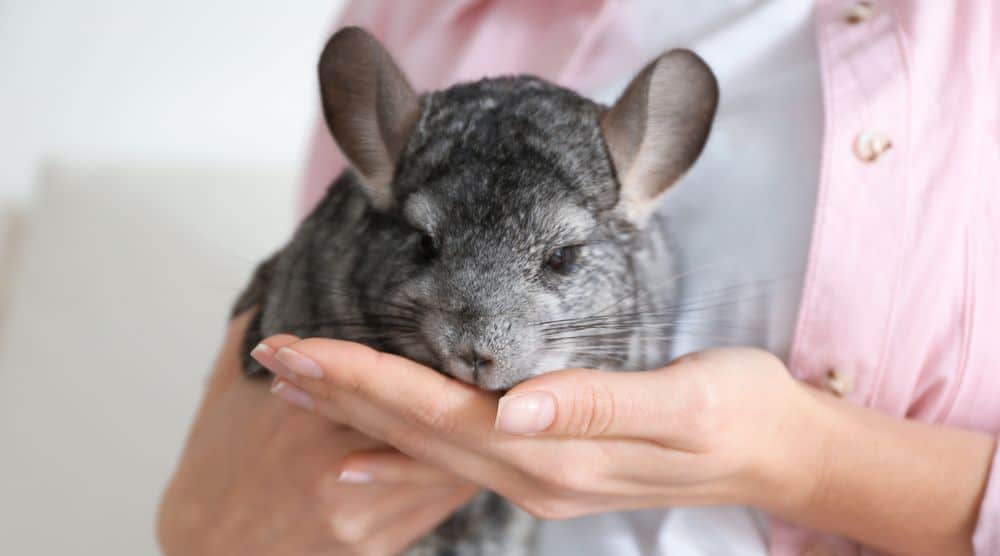
Some of you may have different experiences with this. My chinchilla is only jumpy and shaky during the brief few seconds it takes to get her close to my body.
I have another post worth checking out on this topic as well. It’s all about why a chinchilla may shake.
Once I have my hand beneath her and she’s up close towards my chest, she stops being frantic and trying to jump out of my control.
It’s almost as if she can sense I have no intention of hurting her. She recognizes and loves me and calms down.
This is how it is for me at least and I do understand that some chinchillas just don’t like to be held in general.
In all honesty, picking a chinchilla up by the tail is very easy after you have done it a few times and have good muscle memory of the technique.
Always Support Your Chinchilla From Below For Safety And Comfort
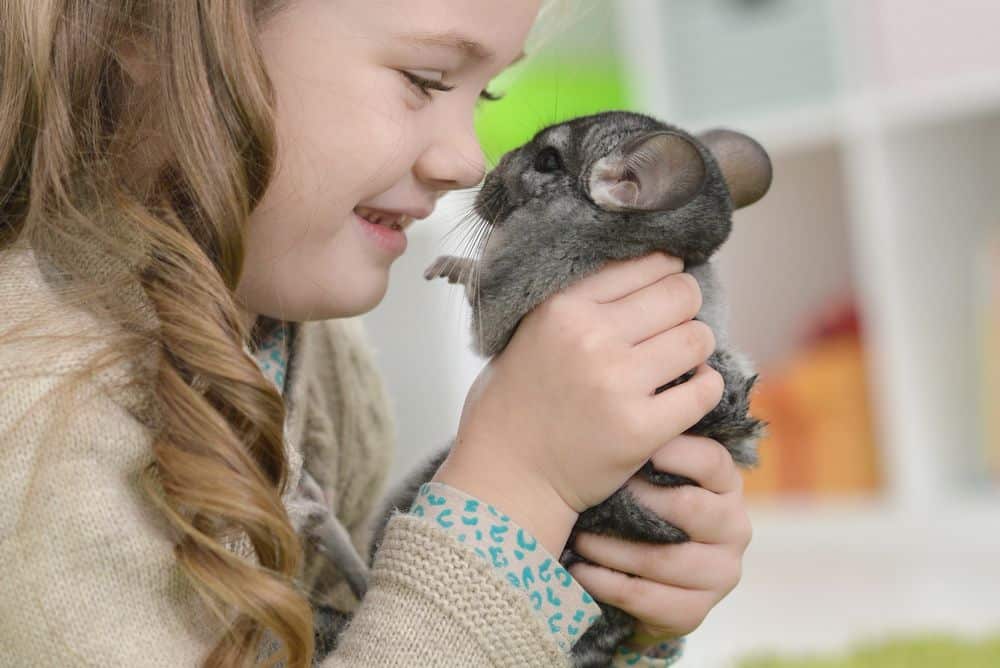
If you do have a chinchilla that seems willing to cuddle and likes to be held, you always need to remember to support its weight.
Chinchillas have very thin fragile bones and it’s important to make sure they are fully supported when being held.
Additionally, them jumping out of your arms and falling on something like concrete or wood floors, landing on anything except their feet, could injure them.
Make sure you are always practicing the proper technique when holding your chinchilla and that its full body is supported by your arms or hands when being held.
This may sound scary or like it’s some big ordeal, but it’s not. Chinchillas are not hard to take care of. It’s one of the reasons they make such great pets.
Proper care and educating yourself about best practices with your chinchilla is not only ethical, but will form a much stronger bond over time with your pet, while keeping it happy and safe.
You can’t beat that, and, in all honesty, you can’t beat owning a chinchilla. I was skeptical at first, but I love my chinchilla just like any other family member or family pet.
They are a joy to be around and will surprise you daily, if you take the time to interact with them and take proper care of them. That’s all there is to it.
Use A Chinchilla Playpen To Practice The Base Of The Tail Technique

For anyone who has read many of my other posts on this website, I am sure you know by now that I am a huge fan of using a chinchilla playpen. For countless reasons.
Well, here is another great reason to consider purchasing a playpen inside which to interact with your chinchilla.
First and foremost, if you are not good at picking your chinchilla up by the base of the tail, here is your safe spot to practice.
It forces your chinchilla to be in a closed-off area with you, which is going to build the bond and will allow you countless times of trying to master the base of the tail technique.
Plus, they are very intelligent rodents. They realize they do not have anywhere to run inside of this playpen so it is likely that they will remain much calmer when you attempt to pick them up by the base of the tail.
I currently use the Jespet 61 inch Playpen and have been using it for the past 4 years.
I cannot say enough good things about using this approach. If you need other options as well to use a chinchilla playpen, be sure to check out my post about the best chinchilla playpens here.
Surely, you can find one that works for you and begin learning how to pick your chinchilla up by the tail in no-time.
What If You Can’t Pick Your Chinchilla Up By The Tail?
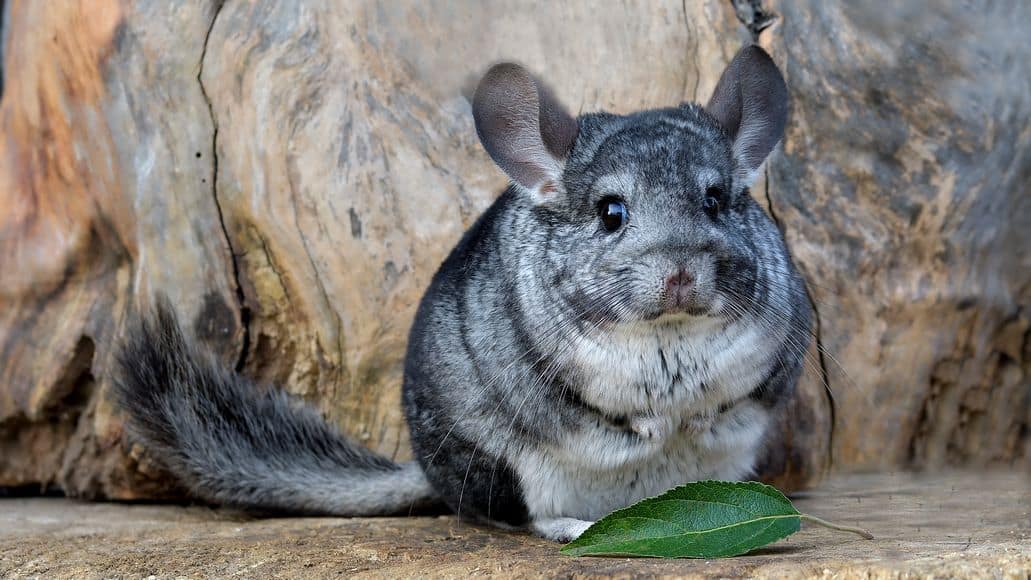
If you are struggling to get the grasp of how to grab your chinchilla by the tail and handle it, you have a few alternatives.
First and foremost, not being able to grab your chinchilla properly is not an excuse not to interact with it.
You just need to get creative.
You can use two other alternatives to get your chinchilla safely back into its cage.
First, try using its dust bath.
Once it is in its dust bath container and has finished fun and playtime, simply pick it up in the dust bath and take it back to its cage.
Again, don’t try capturing it in the dust bath or cornering it. Allow it time out of the cage and wait for it to return to the dust bath. Trust me it will, and it doesn’t take long for this happen.
Sometimes less than a few minutes. They love their dust baths.
Secondly, use a travel cage. This can just be a small cage with some bedding and a chinchilla safe treat in the cage.
If the door is open on the travel container, your pet will get curious and walk into the cage on its own. Don’t force this method either. Simply wait and when it enters the travel cage, simply close the door and return it to the cage.
Of course, you can always try to just leave the cage doors open as well. But this may take longer, because they love their playtime and don’t always want to go back right away.
Hold A Chinchilla By The Tail: Final Thoughts
The two methods discussed previously should only be used until you are more comfortable picking your chinchilla up by the base of the tail.
If you continue to use the other methods, you never fully have any control of your chinchilla and you’re always relying on these techniques.
Learning to pick your chinchilla up by the tail will allow you to control where and when you need your chinchilla to be and allow you to end playtime when you choose.
Additionally, it’s nice to know your chinchilla feels safe and will allow you to do this. I can’t imagine many scenarios where this should be a major struggle to accomplish.
At the end of the day, you need to get over the awkward feeling that picking your chinchilla up by the tail can create.
It doesn’t hurt them and it’s the recommended and safe approach for handling chinchillas properly and returning them to their cage after playtime.
Additionally, there may come a time when you need to take your chinchilla to another location or to a vet and you need to learn this skill to properly care for your chinchilla over the long haul.
Chili and I wish you the best of luck with your new chinchilla and the journey you have ahead of you.
Do you have any further recommendations about holding a chinchilla by the base of the tail?
As always, thanks for stopping by and I appreciate you.
What’re your thoughts on picking your chinchilla up by the base of the tail?
Do you have any further recommendations for the readers that we haven’t discussed in this post?
Be sure to share those thoughts, stories, and concerns by dropping a comment below.
As always, Chili and I appreciate you stopping by and reading today and we will see you again next time.

Leave a Reply